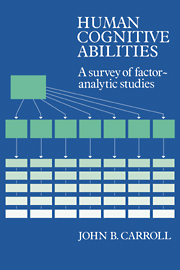Book contents
- Frontmatter
- Contents
- Preface
- PART I INTRODUCTION TO THE SURVEY
- PART II THE IDENTIFICATION AND DESCRIPTION OF COGNITIVE ABILITIES
- Chapter 5 Abilities in the Domain of Language
- Chapter 6 Abilities in the Domain of Reasoning
- Chapter 7 Abilities in the Domain of Memory and Learning
- Chapter 8 Abilities in the Domain of Visual Perception
- Chapter 9 Abilities in the Domain of Auditory Reception
- Chapter 10 Abilities in the Domain of Idea Production
- Chapter 11 Abilities in the Domain of Cognitive Speed
- Chapter 12 Abilities in the Domain of Knowledge and Achievement
- Chapter 13 Psychomotor Abilities
- Chapter 14 Miscellaneous Domains of Ability and Personal Characteristics
- Chapter 15 Higher-Order Factors of Cognitive Ability
- PART III ISSUES
- References and List of Datasets
- Appendix A Codes for Countries, Samples, and Factors
- Appendix B Hierarchical Factor Matrix Files
- Name Index
- Subject Index
Chapter 15 - Higher-Order Factors of Cognitive Ability
Published online by Cambridge University Press: 29 September 2009
- Frontmatter
- Contents
- Preface
- PART I INTRODUCTION TO THE SURVEY
- PART II THE IDENTIFICATION AND DESCRIPTION OF COGNITIVE ABILITIES
- Chapter 5 Abilities in the Domain of Language
- Chapter 6 Abilities in the Domain of Reasoning
- Chapter 7 Abilities in the Domain of Memory and Learning
- Chapter 8 Abilities in the Domain of Visual Perception
- Chapter 9 Abilities in the Domain of Auditory Reception
- Chapter 10 Abilities in the Domain of Idea Production
- Chapter 11 Abilities in the Domain of Cognitive Speed
- Chapter 12 Abilities in the Domain of Knowledge and Achievement
- Chapter 13 Psychomotor Abilities
- Chapter 14 Miscellaneous Domains of Ability and Personal Characteristics
- Chapter 15 Higher-Order Factors of Cognitive Ability
- PART III ISSUES
- References and List of Datasets
- Appendix A Codes for Countries, Samples, and Factors
- Appendix B Hierarchical Factor Matrix Files
- Name Index
- Subject Index
Summary
… all the ground that has been, or ever can be, covered by mental tests may forthwith be mapped out in at least general outlines.
Charles Spearman (1923, p. 354)The previous chapters, from Chapter 5 on, have presented a survey of first-order cognitive ability factors found in the database for this project. They are “first-order” factors in the sense that they emerged from direct analysis of the correlation matrices of the datasets. The factorial procedures chosen for use in the project, however, dictated that when first-order factors rotated to simple structure were found to have substantial intercorrelations, their correlation matrices were to be subjected to further analysis to find one or more “second-order” factors. This process could continue for a further step when second-order factors had substantial intercorrelations, to produce “third-order” factors – in principle, possibly more than one for a given dataset, but it was never the case, for my datasets, that more than one meaningful third-order factor emerged in the analysis. (This was true even for reanalysis of one dataset, HAKS01, whose authors, Hakstian and Cattell, 1978, believed it necessary and desirable to extract three oblique factors at the third order.)
The present chapter reports the results of the higher-order analyses conducted, wherever applicable, on the 467 datasets selected for study in this survey. The chapter thus constitutes a study of the higher-order structure of cognitive abilities. The complete orthogonalized hierarchical factor matrices for the datasets are shown in Appendix B.
- Type
- Chapter
- Information
- Human Cognitive AbilitiesA Survey of Factor-Analytic Studies, pp. 577 - 628Publisher: Cambridge University PressPrint publication year: 1993



